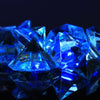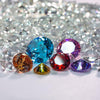
The impact of lab-grown diamonds on the resale market for diamond jewelry
Introduction:
For their sparkle, scarcity, and high cost, laboratory-created diamonds have long been coveted. When lab grown diamonds took place in the market, they disrupted the industry of traditional diamonds. These man made gems offer an ethical and sustainable alternative to naturally occurring diamonds. When lab-grown diamonds gain popularity, it is required to research the resale market for diamond jewelry.
Changing Consumer Perceptions

Lab-grown diamond contains the same chemical properties as natural diamond, but the main difference is the manufacturing. Natural diamonds are mined from the earth, whereas; lab-grown diamonds are crafted in the laboratory. Buyers are becoming more susceptive to lab-made alternatives as they become more conscious of the ethical and environmental concerns related to real diamonds. This change in customer preferences may have an effect on the demand for and resale value of jewelry made using traditionally mined diamonds.
Pricing and Affordability
Laboratory-grown diamonds usually have the advantage of being less expensive. Since they can be produced in controlled environments, lab-grown diamonds bypass the costly and unpredictable mining process. They are therefore typically less expensive than genuine diamonds. This affordability factor can influence the resale market by making diamond jewelry more accessible to a broader range of buyers.
Market Perception and Acceptance
-
Ethical and Sustainable Appeal:
One of the primary factors driving the acceptance of lab-created diamonds is their ethical and sustainable appeal. As consumers become more concerned about the social and environmental impact of their purchases, lab-created diamonds offer a transparent and responsible choice. The assurance of no mining-related harm resonates with individuals seeking to make socially and environmentally conscious decisions, contributing to the growing acceptance of lab-created diamonds.
-
Awareness and Education:

Market perception and acceptance are closely tied to the level of awareness and education about lab-created diamonds. As consumers learn about the technology behind lab-grown diamonds, their physical and chemical properties, and their identical composition to natural diamonds, misconceptions, and doubts are dispelled. Increased education through industry initiatives, jeweler's transparency, and consumer awareness campaigns can positively influence the perception and acceptance of lab-created diamonds.
-
Price and Affordability
lab created diamonds have gained popularity due to their comparatively lower price point. Traditional diamond jewelry often comes with a significant price premium due to the costs associated with mining and scarcity. This makes them more affordable than natural diamonds. The favorable price aspect plays a vital role in driving acceptance, particularly among budget-conscious consumers.
-
Quality and Aesthetics:

lab created diamonds have made significant strides in terms of quality and aesthetics. Advanced technologies used in their production ensure that they possess the same optical and physical properties as natural diamonds. Gemological laboratories provide grading and certification, instilling confidence in consumers about the quality of lab-created diamonds. As the perception of lab-created diamonds' beauty, brilliance, and durability aligns with natural diamonds, acceptance in the market continues to grow.
-
Bridging Fashion and Sustainability:
The growing emphasis on sustainability in the fashion industry has paved the way for lab-created diamonds to gain acceptance. Influencers, celebrities, and designers have started to embrace lab-created diamonds, showcasing them as fashionable and eco-conscious choices. Collaborations between jewelry brands and sustainability-focused initiatives have contributed to the positive perception and acceptance of lab-created diamonds as trendy and responsible alternatives.
-
Evolving Market Dynamics:
The market dynamics are constantly evolving, driven by changing consumer preferences and industry trends. As more jewelers and retailers include lab-created diamonds in their offerings, consumers have a wider range of choices. As lab-created diamonds become more prevalent, their acceptance is gaining traction, making them a valuable option for a broad range of consumers.
The Future of the Resale Market for Diamond Jewelry
-
Sustainable and Ethical Considerations:
The resale market for diamond jewelry is anticipated to be significantly impacted by the growing demand for ethical products and sustainable items. Consumers are increasingly seeking transparency and responsible sourcing in their purchases. This trend may lead to a preference for pre-owned or lab-created diamonds, as they align with sustainability goals and reduce the environmental impact of diamond mining.
-
Online Platforms and Marketplaces:

The increasing popularity of online platforms and marketplaces is fundamentally altering the diamond jewelry resale sector. The growing popularity of online platforms and marketplaces is revolutionizing the resale market for diamond jewelry. The online market makes it easy to sell and purchase pre-owned diamond jewelry, and also provide various option on it. which is very convenient for everyone. Online platforms are probably going to take over the resale industry as technology develops and customer confidence in online transactions rises.
-
Value Retention and Pricing:
The lab-grown diamond resale value is a key consideration for both buyers and sellers in the resale market. Diamond jewelry rates and resale value are affected by variables like the diamond's excellence, how it was made, the company's reputation, and market demand. Consumers can make better-educated choices about the worth of their purchases and possible resale prospects with more transparency and informational availability.
-
Personalization and Customization:
In the jewelry industry, personalization and customization are significant demands that are projected to develop in the resale market. Customers could search for unique, customizable products that are different and meet their interests. To meet this demand, dealers now have the chance to offer specialized services including resizing, resetting, or repurposing diamond jewelry.
-
Custom Design Options:
lab grown diamond jewelry offers a wide range of custom design options. Customers who select bespoke jewelry designs are creating the best decision they can make because the items may be designed to their requirements whether it be an engagement ring, wedding band, pendant, bracelet, or set of earrings. From selecting the diamond shape, carat weight, and color to choosing the metal type and setting style, customization allows for a truly personalized piece of jewelry.
-
Engraving and Personal Messages:

Personalization goes beyond the physical attributes of the jewelry. Engraving offers a way to add a personal touch and meaningful messages to lab grown diamond jewelry. Names, initials, special dates, or even short quotes can be engraved on the metal band or pendant, making the piece uniquely sentimental and memorable.
-
Mix and Match:
Another aspect of customization in lab-grown diamond jewelry is the ability to mix and match different elements. Customers can select different lab-created diamonds in various shapes, sizes, and colors for their diamond jewelry. This allows for creative combinations and unique designs that reflect personal style and preferences.
-
Repurposing and Redesigning:
Customization extends to repurposing and redesigning existing lab-grown diamond jewelry. Individuals can collaborate with jewelers to breathe new life into heirloom pieces or outdated designs. This may involve resetting diamonds into a new setting, incorporating additional gemstones, or transforming a ring into a pendant. Repurposing and redesigning allow for a sustainable and sentimental approach to customizing lab-grown diamond jewelry.
-
Personal Style Expression:
Personalization and customization present people with a platform to express their unique sense of style and produce jewelry that defines who they are. Whether it's a minimalist design, vintage-inspired aesthetics, or contemporary and bold statements, lab-grown diamond jewelry can be customized to match diverse fashion preferences and individual tastes.
-
Collaborative Process:
The customization of lab grown diamond jewelry involves a collaborative process between the consumer and the jeweler. Through consultations and discussions, jewelers can understand the client's vision, offer expert guidance, and translate ideas into exquisite pieces of jewelry. This collaborative approach ensures that the final product meets the client's expectations and exceeds their personalized desires.
-
Changing Consumer Demographics:
As younger generations enter the market as both buyers and sellers, their preferences and values will shape the future of the resale market. Millennials and Gen Z consumers often prioritize sustainability, uniqueness, and affordability. They may be more inclined to explore pre-owned or lab-created diamond jewelry, driving a shift in the market's focus and offerings.
-
Authentication and Certification:
Processes for authenticity and certification will continue to be important in the resale market for diamond jewelry in an industry where assurance and authenticity are key. Buyers will rely on reputable Gemological laboratories and certifications to ensure the quality and legitimacy of the diamonds they purchase. Blockchain-based authentication approaches, for example, might further enhance transparency and consumer confidence.
-
Circular Economy Initiatives:
The concept of a circular economy, in which goods are recycled or utilized rather than discarded, is gaining popularity. In the resale market for diamond jewelry, circular economy initiatives can promote sustainability and reduce waste by extending the lifecycle of diamond jewelry. Collaboration between jewelers, retailers, and consumers will be key to fostering a circular economy ecosystem for diamond jewelry.
Resale Market Differentiation
As lab-grown diamonds gain traction, a distinct resale market for lab-grown diamond jewelry may emerge. Some specialized platforms and retailers are already catering specifically to lab-grown diamonds, offering a dedicated marketplace for buying and selling these gems. This differentiation can influence the perceived value and market dynamics for lab-grown diamond jewelry.
Educating Consumers
Educating purchasers about the differences between lab-made and real diamonds is more beneficial for resale and market. Comprehension of the demand for lab-created diamonds, including their growth process and certification levels, can help buyers make correct decisions when purchasing or reselling diamond jewelry. Efforts to educate consumers can contribute to building trust and confidence in the lab-grown diamond resale market.
Conclusion
The popularity of lab-grown diamonds has undoubtedly affected the traditional diamond industry, involving the resale sector for diamond jewelry. While it is still a relatively new phenomenon, lab diamonds have the potential to reshape consumer perceptions, accessibility, and market variability. As the industry continues to progress and consumers become more knowledgeable relate lab-grown diamonds, it will be fascinating to notice how their presence impacts the resale industry and the overall jewelry industry.
Leave a comment
Please note, comments must be approved before they are published.











